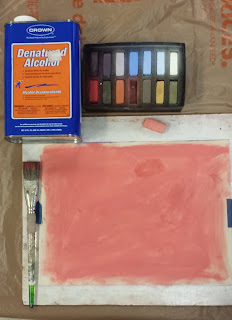 |
| "Green Hope River" 12" x 14" in private collection |
I ran across a painting from a couple of years ago, and remembered I had done photos during the process, for a future blog. I am now posting it, with some "hindsight is always 20-20" comments!
This is using a photo from our trip, in 2015, to England. We stayed at a wonderful series of B and B's, some were "Pubs with Rooms" and all were very special in their own way. This was called "Green Hope Guest House, in northern Yorkshire. It was back a LONG farm track, but when we got there, it was a gorgeous stream-side garden-strewn home. I took this photo looking back along the stream, toward the pastures and treeline, early morning, the day we left. This is the reference photo.
I knew I did not want to paint the whole view, too much going on, so I did a few thumbnail sketches to get the value shapes I thought would work. The one on the upper left became two other paintings, but I decided for this larger one, I wanted the one at the bottom of the page.
Next I did an underpainting, using complimentary colors so the mostly green scene would have a little "punch.
I am showing a close-up of the top of the painting here
I had decided I did not want this painting to be just GREEN, so I am going to underpaint warmer colors to begin.
I have also blocked in the light blue haze in the distance, and some cool blue greens of the far stands of pine trees. I will continue to add color, to build up the pastel to where I think I will finish with the greens.
NOTE; When rediscovering these photos of the steps for this painting, I am really regretting having taken this painting any further than this stage. Two years later, after much study , workshops, as well as two more years of teaching my pastel classes under my belt, I see that THIS is the painting I had wanted to do! I jave been struggling with leaving detail OUT of my work, letting the feeling of the place reign, rather than the worrying the little details to death!
Step 6. However, I DID continue on this painting, and here is the final result. I built up the warm greens of the grasses, the cooler, darker blues in the background, and added details of shrubbery, the right foreground tree, and some flowers.
Not sure which I like best, but since the Step 5 one no longer exists, other than beneath the finished one, I guess I have to be happy! Maybe I will do a whole new painting!
For those who are interested, I painted this on 400 Uart sanded paper, with Terry Ludwig pastels.


























